Analysis of Business Communication and Information Principles
VerifiedAdded on 2020/06/03
|11
|3289
|117
Report
AI Summary
This report delves into the core principles of business communication, emphasizing clarity, completeness, and other key aspects. It examines the importance of negotiation in the business environment, detailing various approaches such as distributive, compromise, and impersonal strategies, along with the components of effective negotiation techniques. The report also covers different types of presentations, resources used in their development, and best practices for delivery, including the use of feedback. Furthermore, it explores the creation of bespoke documents, legal requirements, and relevant techniques. Finally, the report addresses issues within the system development life cycle, benefits and limitations of different information systems, and legal, security, and confidentiality requirements, concluding with a discussion on monitoring the use and effectiveness of information systems. This comprehensive analysis provides valuable insights into effective business communication practices and their application in various contexts.
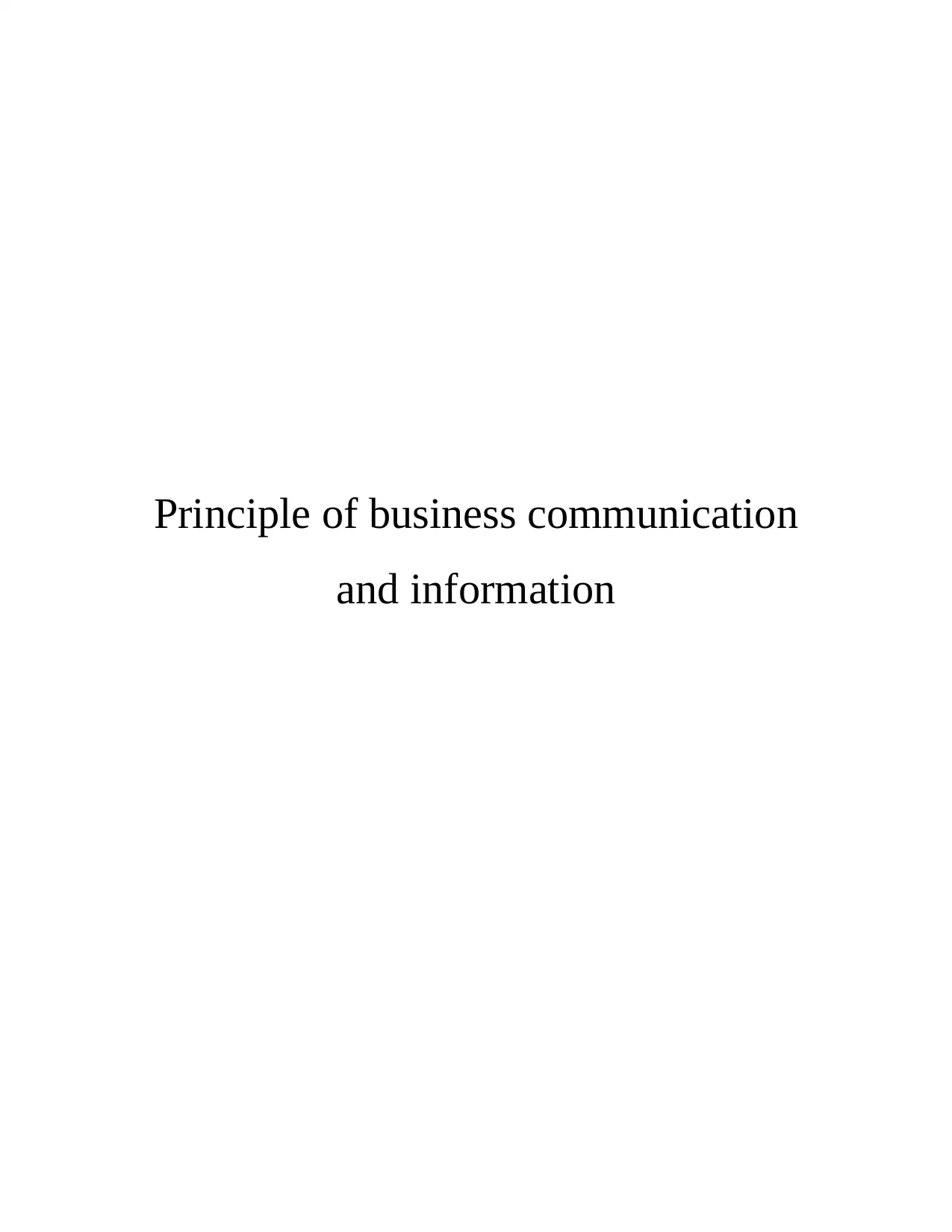
Principle of business communication
and information
and information
Paraphrase This Document
Need a fresh take? Get an instant paraphrase of this document with our AI Paraphraser
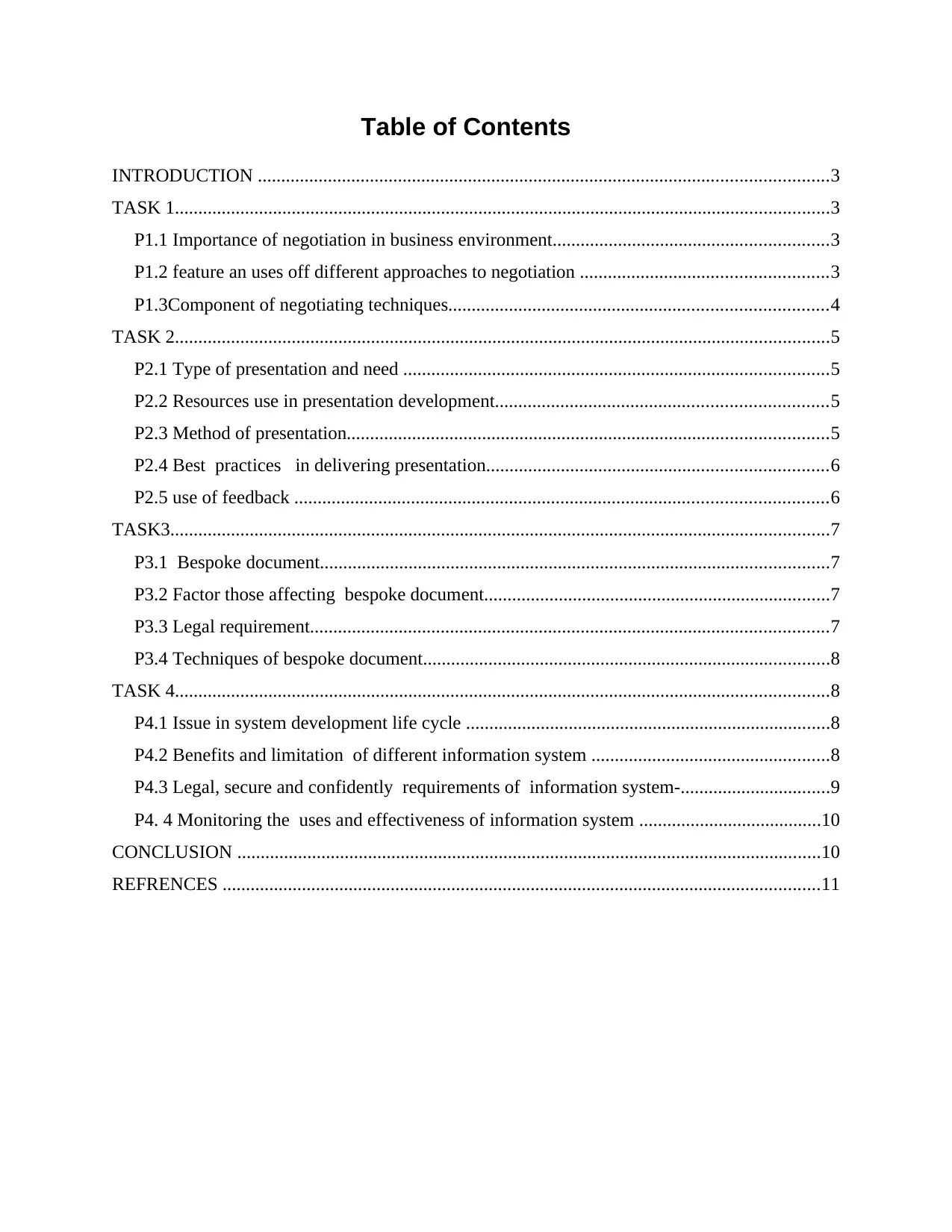
Table of Contents
INTRODUCTION ..........................................................................................................................3
TASK 1............................................................................................................................................3
P1.1 Importance of negotiation in business environment...........................................................3
P1.2 feature an uses off different approaches to negotiation .....................................................3
P1.3Component of negotiating techniques.................................................................................4
TASK 2............................................................................................................................................5
P2.1 Type of presentation and need ...........................................................................................5
P2.2 Resources use in presentation development.......................................................................5
P2.3 Method of presentation.......................................................................................................5
P2.4 Best practices in delivering presentation.........................................................................6
P2.5 use of feedback ..................................................................................................................6
TASK3.............................................................................................................................................7
P3.1 Bespoke document.............................................................................................................7
P3.2 Factor those affecting bespoke document..........................................................................7
P3.3 Legal requirement...............................................................................................................7
P3.4 Techniques of bespoke document.......................................................................................8
TASK 4............................................................................................................................................8
P4.1 Issue in system development life cycle ..............................................................................8
P4.2 Benefits and limitation of different information system ...................................................8
P4.3 Legal, secure and confidently requirements of information system-................................9
P4. 4 Monitoring the uses and effectiveness of information system .......................................10
CONCLUSION .............................................................................................................................10
REFRENCES ................................................................................................................................11
INTRODUCTION ..........................................................................................................................3
TASK 1............................................................................................................................................3
P1.1 Importance of negotiation in business environment...........................................................3
P1.2 feature an uses off different approaches to negotiation .....................................................3
P1.3Component of negotiating techniques.................................................................................4
TASK 2............................................................................................................................................5
P2.1 Type of presentation and need ...........................................................................................5
P2.2 Resources use in presentation development.......................................................................5
P2.3 Method of presentation.......................................................................................................5
P2.4 Best practices in delivering presentation.........................................................................6
P2.5 use of feedback ..................................................................................................................6
TASK3.............................................................................................................................................7
P3.1 Bespoke document.............................................................................................................7
P3.2 Factor those affecting bespoke document..........................................................................7
P3.3 Legal requirement...............................................................................................................7
P3.4 Techniques of bespoke document.......................................................................................8
TASK 4............................................................................................................................................8
P4.1 Issue in system development life cycle ..............................................................................8
P4.2 Benefits and limitation of different information system ...................................................8
P4.3 Legal, secure and confidently requirements of information system-................................9
P4. 4 Monitoring the uses and effectiveness of information system .......................................10
CONCLUSION .............................................................................................................................10
REFRENCES ................................................................................................................................11
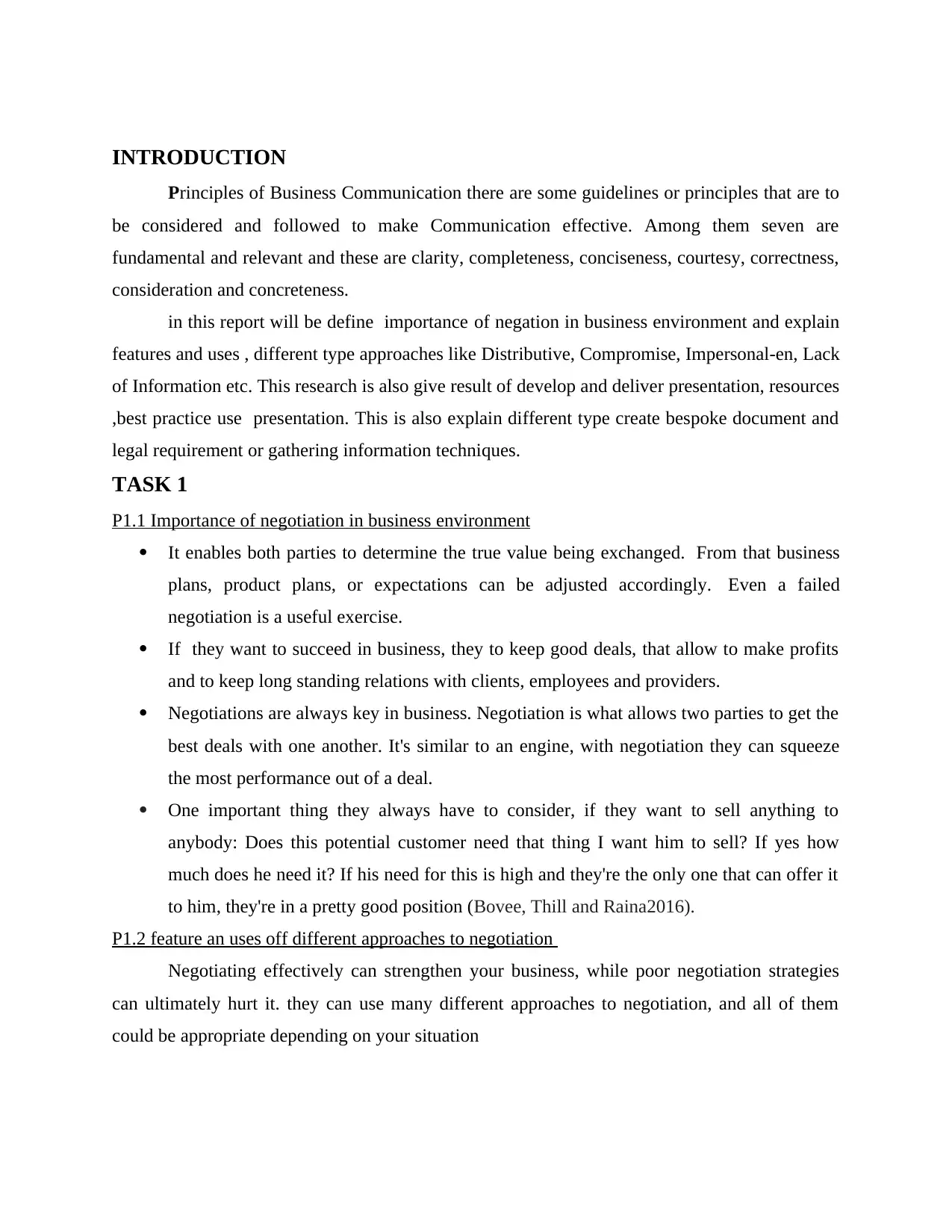
INTRODUCTION
Principles of Business Communication there are some guidelines or principles that are to
be considered and followed to make Communication effective. Among them seven are
fundamental and relevant and these are clarity, completeness, conciseness, courtesy, correctness,
consideration and concreteness.
in this report will be define importance of negation in business environment and explain
features and uses , different type approaches like Distributive, Compromise, Impersonal-en, Lack
of Information etc. This research is also give result of develop and deliver presentation, resources
,best practice use presentation. This is also explain different type create bespoke document and
legal requirement or gathering information techniques.
TASK 1
P1.1 Importance of negotiation in business environment
It enables both parties to determine the true value being exchanged. From that business
plans, product plans, or expectations can be adjusted accordingly. Even a failed
negotiation is a useful exercise.
If they want to succeed in business, they to keep good deals, that allow to make profits
and to keep long standing relations with clients, employees and providers.
Negotiations are always key in business. Negotiation is what allows two parties to get the
best deals with one another. It's similar to an engine, with negotiation they can squeeze
the most performance out of a deal.
One important thing they always have to consider, if they want to sell anything to
anybody: Does this potential customer need that thing I want him to sell? If yes how
much does he need it? If his need for this is high and they're the only one that can offer it
to him, they're in a pretty good position (Bovee, Thill and Raina2016).
P1.2 feature an uses off different approaches to negotiation
Negotiating effectively can strengthen your business, while poor negotiation strategies
can ultimately hurt it. they can use many different approaches to negotiation, and all of them
could be appropriate depending on your situation
Principles of Business Communication there are some guidelines or principles that are to
be considered and followed to make Communication effective. Among them seven are
fundamental and relevant and these are clarity, completeness, conciseness, courtesy, correctness,
consideration and concreteness.
in this report will be define importance of negation in business environment and explain
features and uses , different type approaches like Distributive, Compromise, Impersonal-en, Lack
of Information etc. This research is also give result of develop and deliver presentation, resources
,best practice use presentation. This is also explain different type create bespoke document and
legal requirement or gathering information techniques.
TASK 1
P1.1 Importance of negotiation in business environment
It enables both parties to determine the true value being exchanged. From that business
plans, product plans, or expectations can be adjusted accordingly. Even a failed
negotiation is a useful exercise.
If they want to succeed in business, they to keep good deals, that allow to make profits
and to keep long standing relations with clients, employees and providers.
Negotiations are always key in business. Negotiation is what allows two parties to get the
best deals with one another. It's similar to an engine, with negotiation they can squeeze
the most performance out of a deal.
One important thing they always have to consider, if they want to sell anything to
anybody: Does this potential customer need that thing I want him to sell? If yes how
much does he need it? If his need for this is high and they're the only one that can offer it
to him, they're in a pretty good position (Bovee, Thill and Raina2016).
P1.2 feature an uses off different approaches to negotiation
Negotiating effectively can strengthen your business, while poor negotiation strategies
can ultimately hurt it. they can use many different approaches to negotiation, and all of them
could be appropriate depending on your situation
⊘ This is a preview!⊘
Do you want full access?
Subscribe today to unlock all pages.

Trusted by 1+ million students worldwide
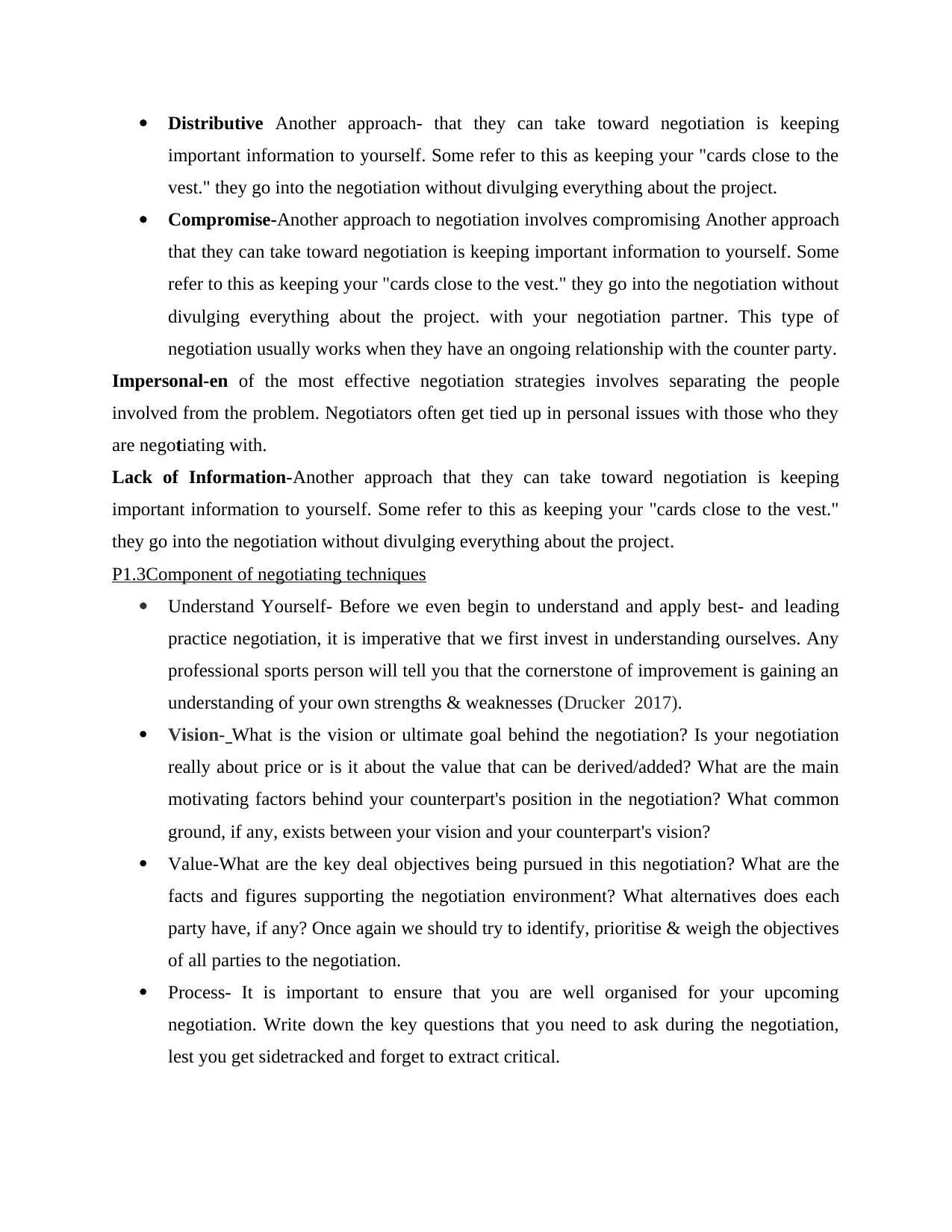
Distributive Another approach- that they can take toward negotiation is keeping
important information to yourself. Some refer to this as keeping your "cards close to the
vest." they go into the negotiation without divulging everything about the project.
Compromise-Another approach to negotiation involves compromising Another approach
that they can take toward negotiation is keeping important information to yourself. Some
refer to this as keeping your "cards close to the vest." they go into the negotiation without
divulging everything about the project. with your negotiation partner. This type of
negotiation usually works when they have an ongoing relationship with the counter party.
Impersonal-en of the most effective negotiation strategies involves separating the people
involved from the problem. Negotiators often get tied up in personal issues with those who they
are negotiating with.
Lack of Information-Another approach that they can take toward negotiation is keeping
important information to yourself. Some refer to this as keeping your "cards close to the vest."
they go into the negotiation without divulging everything about the project.
P1.3Component of negotiating techniques
Understand Yourself- Before we even begin to understand and apply best- and leading
practice negotiation, it is imperative that we first invest in understanding ourselves. Any
professional sports person will tell you that the cornerstone of improvement is gaining an
understanding of your own strengths & weaknesses (Drucker 2017).
Vision- What is the vision or ultimate goal behind the negotiation? Is your negotiation
really about price or is it about the value that can be derived/added? What are the main
motivating factors behind your counterpart's position in the negotiation? What common
ground, if any, exists between your vision and your counterpart's vision?
Value-What are the key deal objectives being pursued in this negotiation? What are the
facts and figures supporting the negotiation environment? What alternatives does each
party have, if any? Once again we should try to identify, prioritise & weigh the objectives
of all parties to the negotiation.
Process- It is important to ensure that you are well organised for your upcoming
negotiation. Write down the key questions that you need to ask during the negotiation,
lest you get sidetracked and forget to extract critical.
important information to yourself. Some refer to this as keeping your "cards close to the
vest." they go into the negotiation without divulging everything about the project.
Compromise-Another approach to negotiation involves compromising Another approach
that they can take toward negotiation is keeping important information to yourself. Some
refer to this as keeping your "cards close to the vest." they go into the negotiation without
divulging everything about the project. with your negotiation partner. This type of
negotiation usually works when they have an ongoing relationship with the counter party.
Impersonal-en of the most effective negotiation strategies involves separating the people
involved from the problem. Negotiators often get tied up in personal issues with those who they
are negotiating with.
Lack of Information-Another approach that they can take toward negotiation is keeping
important information to yourself. Some refer to this as keeping your "cards close to the vest."
they go into the negotiation without divulging everything about the project.
P1.3Component of negotiating techniques
Understand Yourself- Before we even begin to understand and apply best- and leading
practice negotiation, it is imperative that we first invest in understanding ourselves. Any
professional sports person will tell you that the cornerstone of improvement is gaining an
understanding of your own strengths & weaknesses (Drucker 2017).
Vision- What is the vision or ultimate goal behind the negotiation? Is your negotiation
really about price or is it about the value that can be derived/added? What are the main
motivating factors behind your counterpart's position in the negotiation? What common
ground, if any, exists between your vision and your counterpart's vision?
Value-What are the key deal objectives being pursued in this negotiation? What are the
facts and figures supporting the negotiation environment? What alternatives does each
party have, if any? Once again we should try to identify, prioritise & weigh the objectives
of all parties to the negotiation.
Process- It is important to ensure that you are well organised for your upcoming
negotiation. Write down the key questions that you need to ask during the negotiation,
lest you get sidetracked and forget to extract critical.
Paraphrase This Document
Need a fresh take? Get an instant paraphrase of this document with our AI Paraphraser
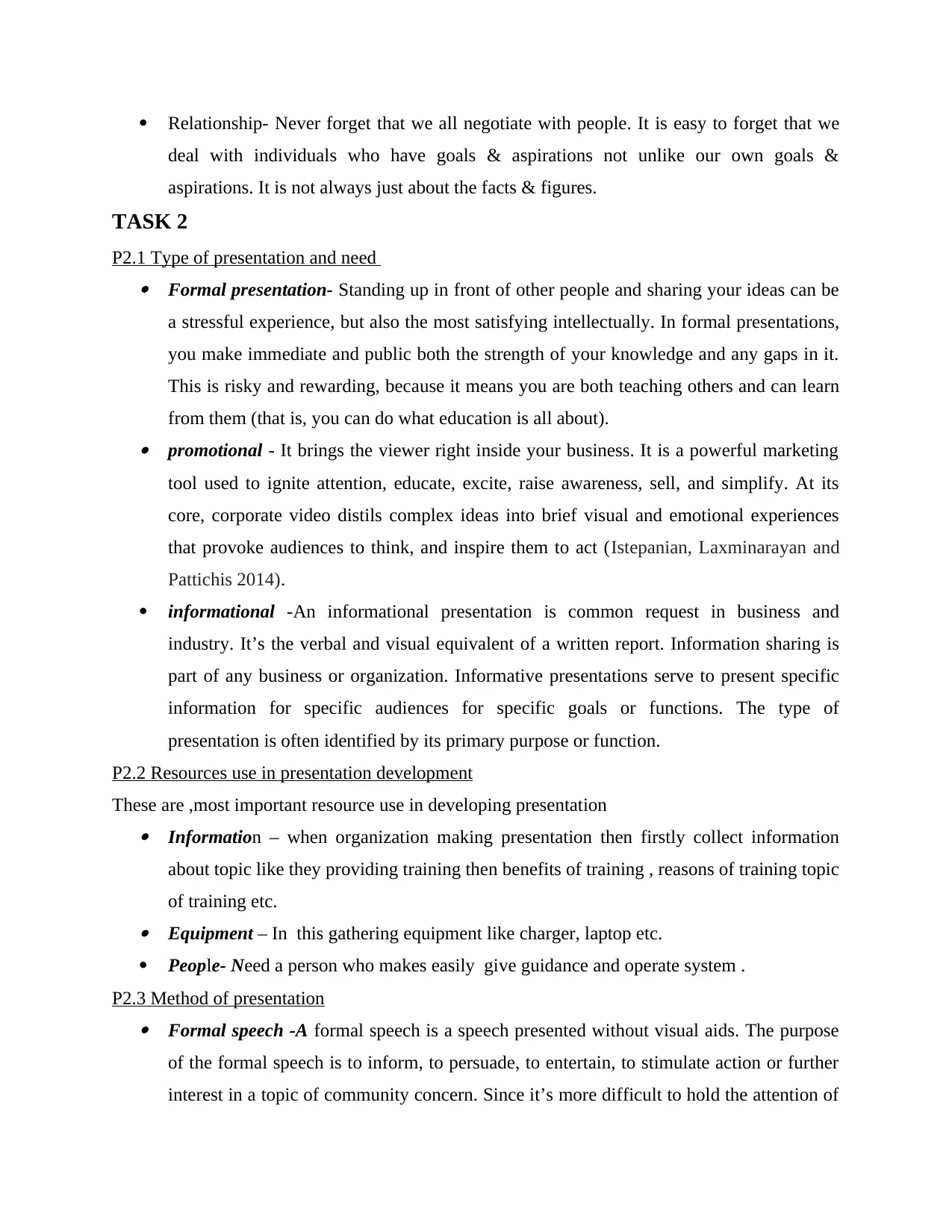
Relationship- Never forget that we all negotiate with people. It is easy to forget that we
deal with individuals who have goals & aspirations not unlike our own goals &
aspirations. It is not always just about the facts & figures.
TASK 2
P2.1 Type of presentation and need Formal presentation- Standing up in front of other people and sharing your ideas can be
a stressful experience, but also the most satisfying intellectually. In formal presentations,
you make immediate and public both the strength of your knowledge and any gaps in it.
This is risky and rewarding, because it means you are both teaching others and can learn
from them (that is, you can do what education is all about). promotional - It brings the viewer right inside your business. It is a powerful marketing
tool used to ignite attention, educate, excite, raise awareness, sell, and simplify. At its
core, corporate video distils complex ideas into brief visual and emotional experiences
that provoke audiences to think, and inspire them to act (Istepanian, Laxminarayan and
Pattichis 2014).
informational -An informational presentation is common request in business and
industry. It’s the verbal and visual equivalent of a written report. Information sharing is
part of any business or organization. Informative presentations serve to present specific
information for specific audiences for specific goals or functions. The type of
presentation is often identified by its primary purpose or function.
P2.2 Resources use in presentation development
These are ,most important resource use in developing presentation Information – when organization making presentation then firstly collect information
about topic like they providing training then benefits of training , reasons of training topic
of training etc. Equipment – In this gathering equipment like charger, laptop etc.
People- Need a person who makes easily give guidance and operate system .
P2.3 Method of presentation Formal speech -A formal speech is a speech presented without visual aids. The purpose
of the formal speech is to inform, to persuade, to entertain, to stimulate action or further
interest in a topic of community concern. Since it’s more difficult to hold the attention of
deal with individuals who have goals & aspirations not unlike our own goals &
aspirations. It is not always just about the facts & figures.
TASK 2
P2.1 Type of presentation and need Formal presentation- Standing up in front of other people and sharing your ideas can be
a stressful experience, but also the most satisfying intellectually. In formal presentations,
you make immediate and public both the strength of your knowledge and any gaps in it.
This is risky and rewarding, because it means you are both teaching others and can learn
from them (that is, you can do what education is all about). promotional - It brings the viewer right inside your business. It is a powerful marketing
tool used to ignite attention, educate, excite, raise awareness, sell, and simplify. At its
core, corporate video distils complex ideas into brief visual and emotional experiences
that provoke audiences to think, and inspire them to act (Istepanian, Laxminarayan and
Pattichis 2014).
informational -An informational presentation is common request in business and
industry. It’s the verbal and visual equivalent of a written report. Information sharing is
part of any business or organization. Informative presentations serve to present specific
information for specific audiences for specific goals or functions. The type of
presentation is often identified by its primary purpose or function.
P2.2 Resources use in presentation development
These are ,most important resource use in developing presentation Information – when organization making presentation then firstly collect information
about topic like they providing training then benefits of training , reasons of training topic
of training etc. Equipment – In this gathering equipment like charger, laptop etc.
People- Need a person who makes easily give guidance and operate system .
P2.3 Method of presentation Formal speech -A formal speech is a speech presented without visual aids. The purpose
of the formal speech is to inform, to persuade, to entertain, to stimulate action or further
interest in a topic of community concern. Since it’s more difficult to hold the attention of
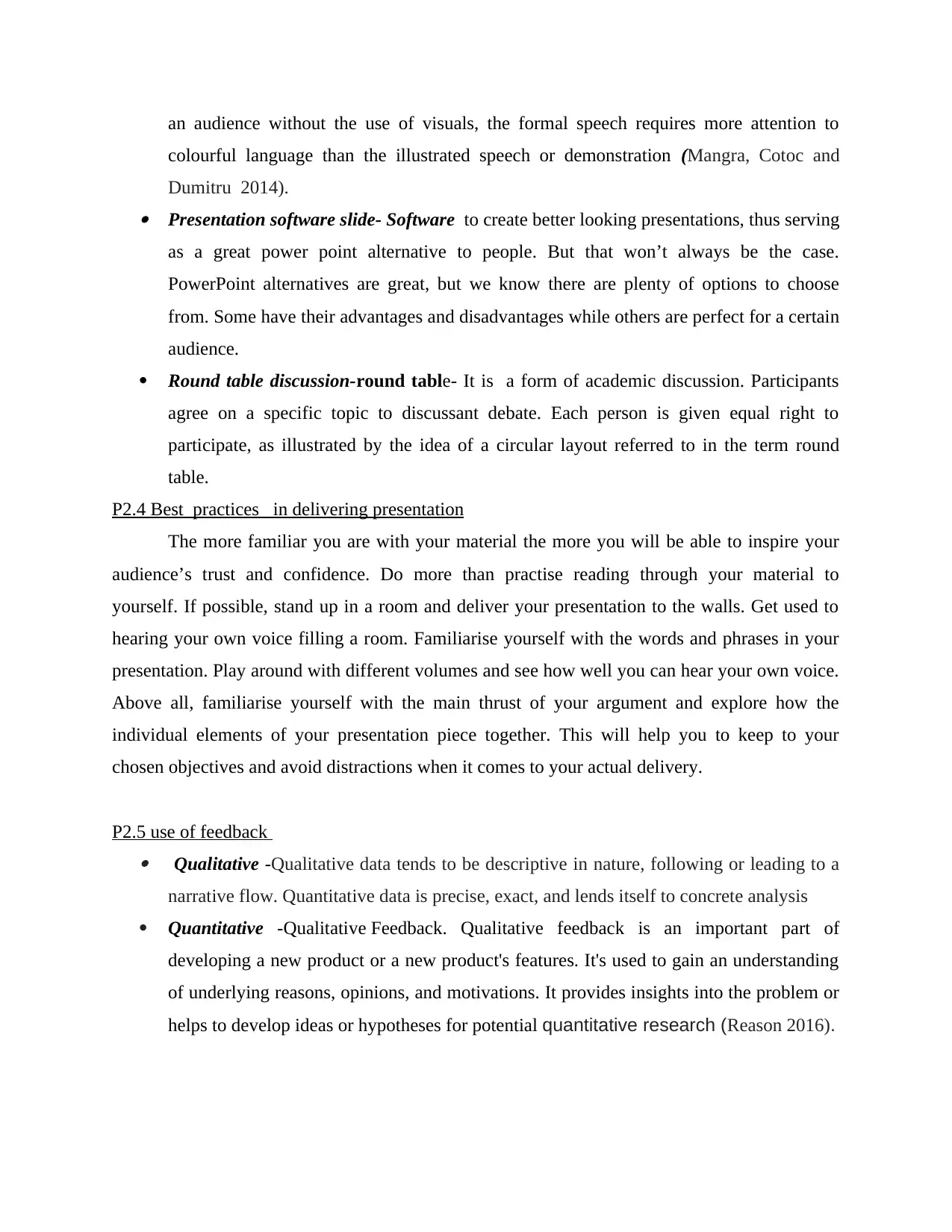
an audience without the use of visuals, the formal speech requires more attention to
colourful language than the illustrated speech or demonstration (Mangra, Cotoc and
Dumitru 2014). Presentation software slide- Software to create better looking presentations, thus serving
as a great power point alternative to people. But that won’t always be the case.
PowerPoint alternatives are great, but we know there are plenty of options to choose
from. Some have their advantages and disadvantages while others are perfect for a certain
audience.
Round table discussion-round table- It is a form of academic discussion. Participants
agree on a specific topic to discussant debate. Each person is given equal right to
participate, as illustrated by the idea of a circular layout referred to in the term round
table.
P2.4 Best practices in delivering presentation
The more familiar you are with your material the more you will be able to inspire your
audience’s trust and confidence. Do more than practise reading through your material to
yourself. If possible, stand up in a room and deliver your presentation to the walls. Get used to
hearing your own voice filling a room. Familiarise yourself with the words and phrases in your
presentation. Play around with different volumes and see how well you can hear your own voice.
Above all, familiarise yourself with the main thrust of your argument and explore how the
individual elements of your presentation piece together. This will help you to keep to your
chosen objectives and avoid distractions when it comes to your actual delivery.
P2.5 use of feedback Qualitative -Qualitative data tends to be descriptive in nature, following or leading to a
narrative flow. Quantitative data is precise, exact, and lends itself to concrete analysis
Quantitative -Qualitative Feedback. Qualitative feedback is an important part of
developing a new product or a new product's features. It's used to gain an understanding
of underlying reasons, opinions, and motivations. It provides insights into the problem or
helps to develop ideas or hypotheses for potential quantitative research (Reason 2016).
colourful language than the illustrated speech or demonstration (Mangra, Cotoc and
Dumitru 2014). Presentation software slide- Software to create better looking presentations, thus serving
as a great power point alternative to people. But that won’t always be the case.
PowerPoint alternatives are great, but we know there are plenty of options to choose
from. Some have their advantages and disadvantages while others are perfect for a certain
audience.
Round table discussion-round table- It is a form of academic discussion. Participants
agree on a specific topic to discussant debate. Each person is given equal right to
participate, as illustrated by the idea of a circular layout referred to in the term round
table.
P2.4 Best practices in delivering presentation
The more familiar you are with your material the more you will be able to inspire your
audience’s trust and confidence. Do more than practise reading through your material to
yourself. If possible, stand up in a room and deliver your presentation to the walls. Get used to
hearing your own voice filling a room. Familiarise yourself with the words and phrases in your
presentation. Play around with different volumes and see how well you can hear your own voice.
Above all, familiarise yourself with the main thrust of your argument and explore how the
individual elements of your presentation piece together. This will help you to keep to your
chosen objectives and avoid distractions when it comes to your actual delivery.
P2.5 use of feedback Qualitative -Qualitative data tends to be descriptive in nature, following or leading to a
narrative flow. Quantitative data is precise, exact, and lends itself to concrete analysis
Quantitative -Qualitative Feedback. Qualitative feedback is an important part of
developing a new product or a new product's features. It's used to gain an understanding
of underlying reasons, opinions, and motivations. It provides insights into the problem or
helps to develop ideas or hypotheses for potential quantitative research (Reason 2016).
⊘ This is a preview!⊘
Do you want full access?
Subscribe today to unlock all pages.

Trusted by 1+ million students worldwide
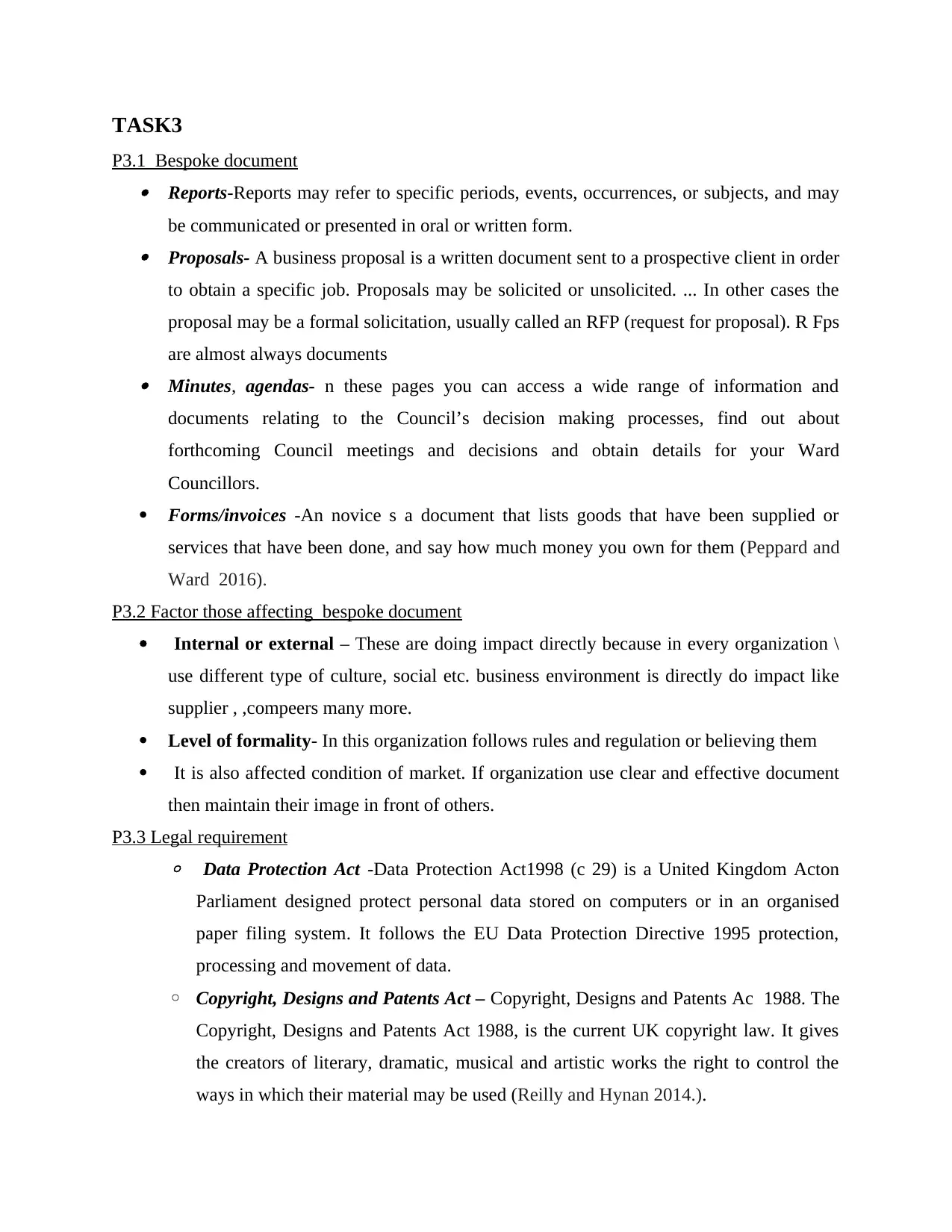
TASK3
P3.1 Bespoke document Reports-Reports may refer to specific periods, events, occurrences, or subjects, and may
be communicated or presented in oral or written form. Proposals- A business proposal is a written document sent to a prospective client in order
to obtain a specific job. Proposals may be solicited or unsolicited. ... In other cases the
proposal may be a formal solicitation, usually called an RFP (request for proposal). R Fps
are almost always documents Minutes, agendas- n these pages you can access a wide range of information and
documents relating to the Council’s decision making processes, find out about
forthcoming Council meetings and decisions and obtain details for your Ward
Councillors.
Forms/invoices -An novice s a document that lists goods that have been supplied or
services that have been done, and say how much money you own for them (Peppard and
Ward 2016).
P3.2 Factor those affecting bespoke document
Internal or external – These are doing impact directly because in every organization \
use different type of culture, social etc. business environment is directly do impact like
supplier , ,compeers many more.
Level of formality- In this organization follows rules and regulation or believing them
It is also affected condition of market. If organization use clear and effective document
then maintain their image in front of others.
P3.3 Legal requirement
◦ Data Protection Act -Data Protection Act1998 (c 29) is a United Kingdom Acton
Parliament designed protect personal data stored on computers or in an organised
paper filing system. It follows the EU Data Protection Directive 1995 protection,
processing and movement of data.
◦ Copyright, Designs and Patents Act – Copyright, Designs and Patents Ac 1988. The
Copyright, Designs and Patents Act 1988, is the current UK copyright law. It gives
the creators of literary, dramatic, musical and artistic works the right to control the
ways in which their material may be used (Reilly and Hynan 2014.).
P3.1 Bespoke document Reports-Reports may refer to specific periods, events, occurrences, or subjects, and may
be communicated or presented in oral or written form. Proposals- A business proposal is a written document sent to a prospective client in order
to obtain a specific job. Proposals may be solicited or unsolicited. ... In other cases the
proposal may be a formal solicitation, usually called an RFP (request for proposal). R Fps
are almost always documents Minutes, agendas- n these pages you can access a wide range of information and
documents relating to the Council’s decision making processes, find out about
forthcoming Council meetings and decisions and obtain details for your Ward
Councillors.
Forms/invoices -An novice s a document that lists goods that have been supplied or
services that have been done, and say how much money you own for them (Peppard and
Ward 2016).
P3.2 Factor those affecting bespoke document
Internal or external – These are doing impact directly because in every organization \
use different type of culture, social etc. business environment is directly do impact like
supplier , ,compeers many more.
Level of formality- In this organization follows rules and regulation or believing them
It is also affected condition of market. If organization use clear and effective document
then maintain their image in front of others.
P3.3 Legal requirement
◦ Data Protection Act -Data Protection Act1998 (c 29) is a United Kingdom Acton
Parliament designed protect personal data stored on computers or in an organised
paper filing system. It follows the EU Data Protection Directive 1995 protection,
processing and movement of data.
◦ Copyright, Designs and Patents Act – Copyright, Designs and Patents Ac 1988. The
Copyright, Designs and Patents Act 1988, is the current UK copyright law. It gives
the creators of literary, dramatic, musical and artistic works the right to control the
ways in which their material may be used (Reilly and Hynan 2014.).
Paraphrase This Document
Need a fresh take? Get an instant paraphrase of this document with our AI Paraphraser
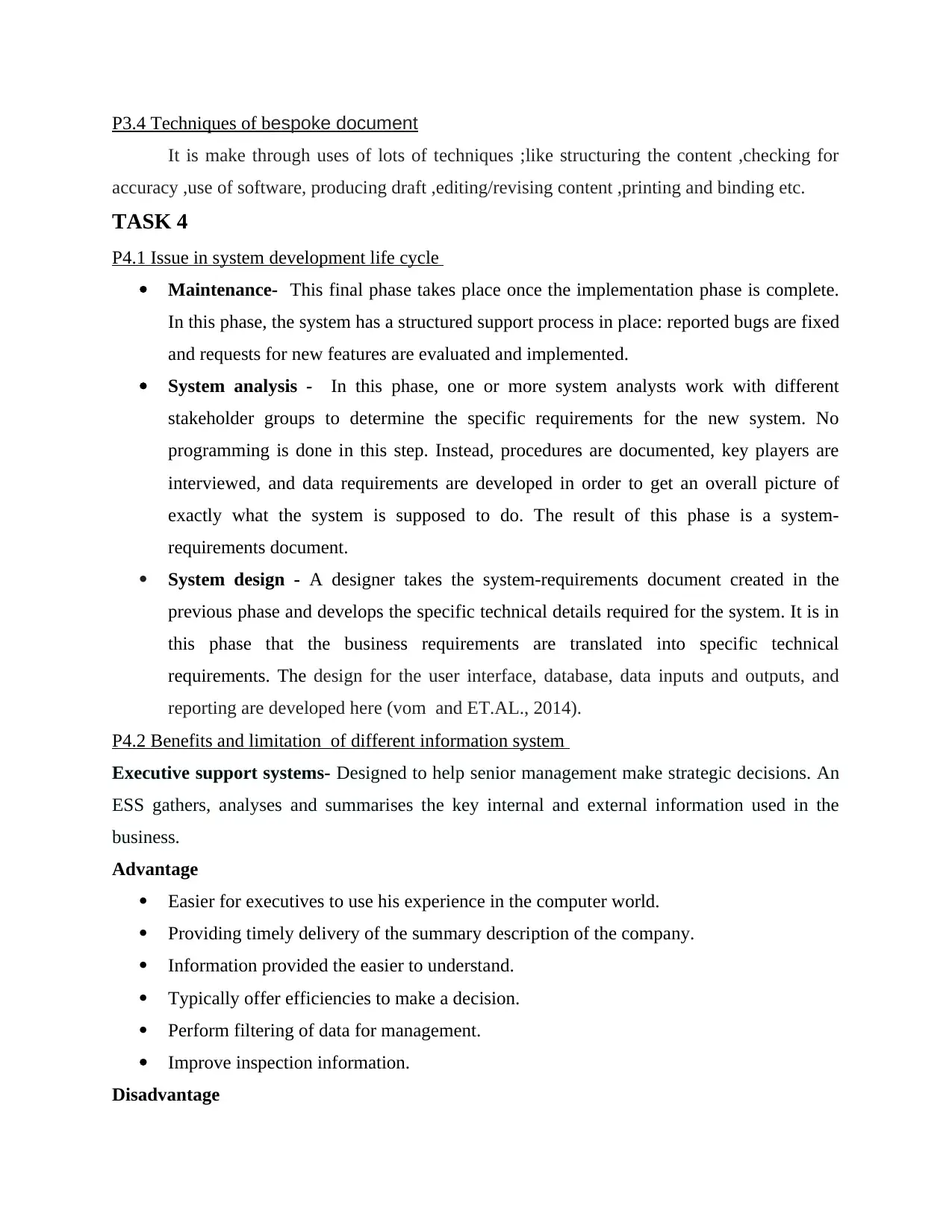
P3.4 Techniques of bespoke document
It is make through uses of lots of techniques ;like structuring the content ,checking for
accuracy ,use of software, producing draft ,editing/revising content ,printing and binding etc.
TASK 4
P4.1 Issue in system development life cycle
Maintenance- This final phase takes place once the implementation phase is complete.
In this phase, the system has a structured support process in place: reported bugs are fixed
and requests for new features are evaluated and implemented.
System analysis - In this phase, one or more system analysts work with different
stakeholder groups to determine the specific requirements for the new system. No
programming is done in this step. Instead, procedures are documented, key players are
interviewed, and data requirements are developed in order to get an overall picture of
exactly what the system is supposed to do. The result of this phase is a system-
requirements document.
System design - A designer takes the system-requirements document created in the
previous phase and develops the specific technical details required for the system. It is in
this phase that the business requirements are translated into specific technical
requirements. The design for the user interface, database, data inputs and outputs, and
reporting are developed here (vom and ET.AL., 2014).
P4.2 Benefits and limitation of different information system
Executive support systems- Designed to help senior management make strategic decisions. An
ESS gathers, analyses and summarises the key internal and external information used in the
business.
Advantage
Easier for executives to use his experience in the computer world.
Providing timely delivery of the summary description of the company.
Information provided the easier to understand.
Typically offer efficiencies to make a decision.
Perform filtering of data for management.
Improve inspection information.
Disadvantage
It is make through uses of lots of techniques ;like structuring the content ,checking for
accuracy ,use of software, producing draft ,editing/revising content ,printing and binding etc.
TASK 4
P4.1 Issue in system development life cycle
Maintenance- This final phase takes place once the implementation phase is complete.
In this phase, the system has a structured support process in place: reported bugs are fixed
and requests for new features are evaluated and implemented.
System analysis - In this phase, one or more system analysts work with different
stakeholder groups to determine the specific requirements for the new system. No
programming is done in this step. Instead, procedures are documented, key players are
interviewed, and data requirements are developed in order to get an overall picture of
exactly what the system is supposed to do. The result of this phase is a system-
requirements document.
System design - A designer takes the system-requirements document created in the
previous phase and develops the specific technical details required for the system. It is in
this phase that the business requirements are translated into specific technical
requirements. The design for the user interface, database, data inputs and outputs, and
reporting are developed here (vom and ET.AL., 2014).
P4.2 Benefits and limitation of different information system
Executive support systems- Designed to help senior management make strategic decisions. An
ESS gathers, analyses and summarises the key internal and external information used in the
business.
Advantage
Easier for executives to use his experience in the computer world.
Providing timely delivery of the summary description of the company.
Information provided the easier to understand.
Typically offer efficiencies to make a decision.
Perform filtering of data for management.
Improve inspection information.
Disadvantage
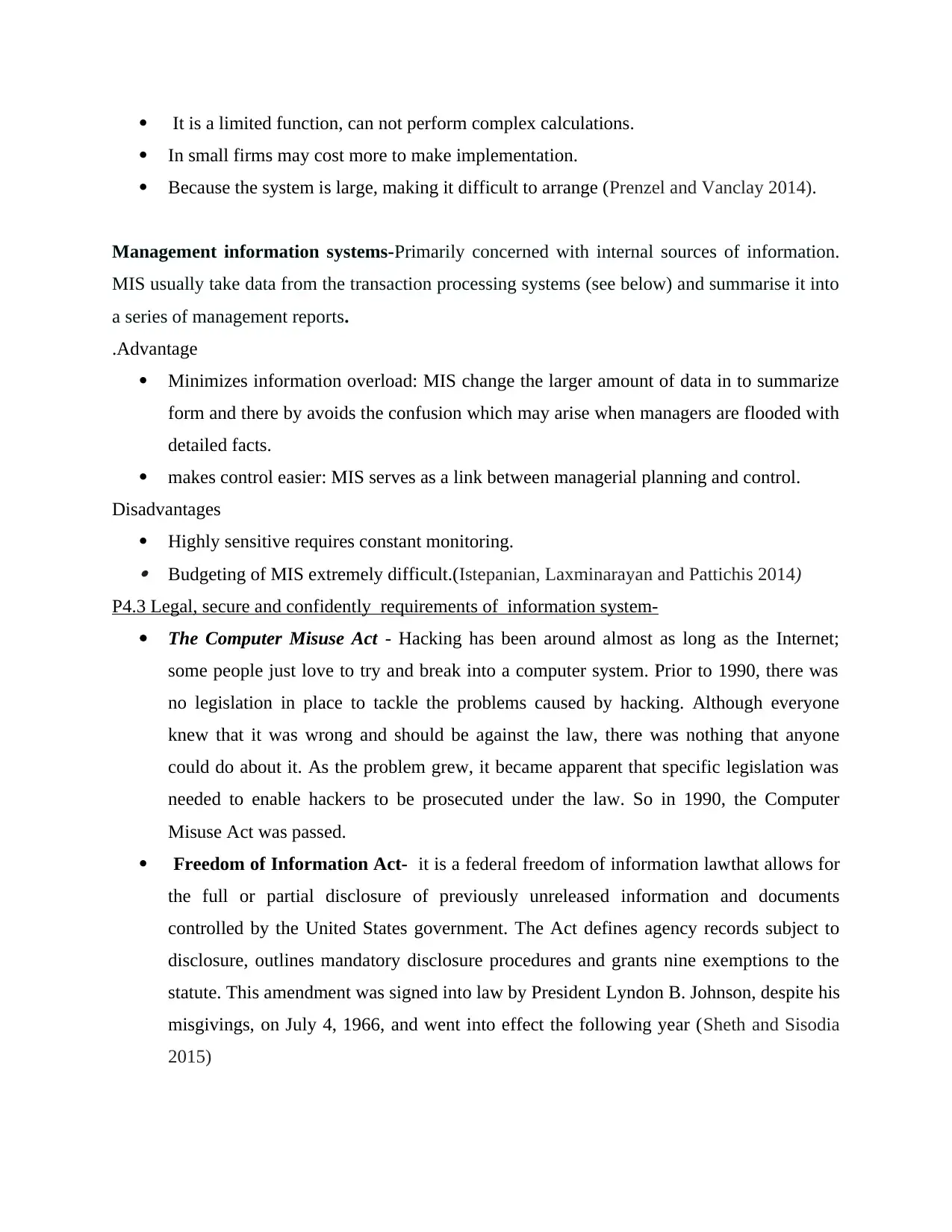
It is a limited function, can not perform complex calculations.
In small firms may cost more to make implementation.
Because the system is large, making it difficult to arrange (Prenzel and Vanclay 2014).
Management information systems-Primarily concerned with internal sources of information.
MIS usually take data from the transaction processing systems (see below) and summarise it into
a series of management reports.
.Advantage
Minimizes information overload: MIS change the larger amount of data in to summarize
form and there by avoids the confusion which may arise when managers are flooded with
detailed facts.
makes control easier: MIS serves as a link between managerial planning and control.
Disadvantages
Highly sensitive requires constant monitoring. Budgeting of MIS extremely difficult.(Istepanian, Laxminarayan and Pattichis 2014)
P4.3 Legal, secure and confidently requirements of information system-
The Computer Misuse Act - Hacking has been around almost as long as the Internet;
some people just love to try and break into a computer system. Prior to 1990, there was
no legislation in place to tackle the problems caused by hacking. Although everyone
knew that it was wrong and should be against the law, there was nothing that anyone
could do about it. As the problem grew, it became apparent that specific legislation was
needed to enable hackers to be prosecuted under the law. So in 1990, the Computer
Misuse Act was passed.
Freedom of Information Act- it is a federal freedom of information lawthat allows for
the full or partial disclosure of previously unreleased information and documents
controlled by the United States government. The Act defines agency records subject to
disclosure, outlines mandatory disclosure procedures and grants nine exemptions to the
statute. This amendment was signed into law by President Lyndon B. Johnson, despite his
misgivings, on July 4, 1966, and went into effect the following year (Sheth and Sisodia
2015)
In small firms may cost more to make implementation.
Because the system is large, making it difficult to arrange (Prenzel and Vanclay 2014).
Management information systems-Primarily concerned with internal sources of information.
MIS usually take data from the transaction processing systems (see below) and summarise it into
a series of management reports.
.Advantage
Minimizes information overload: MIS change the larger amount of data in to summarize
form and there by avoids the confusion which may arise when managers are flooded with
detailed facts.
makes control easier: MIS serves as a link between managerial planning and control.
Disadvantages
Highly sensitive requires constant monitoring. Budgeting of MIS extremely difficult.(Istepanian, Laxminarayan and Pattichis 2014)
P4.3 Legal, secure and confidently requirements of information system-
The Computer Misuse Act - Hacking has been around almost as long as the Internet;
some people just love to try and break into a computer system. Prior to 1990, there was
no legislation in place to tackle the problems caused by hacking. Although everyone
knew that it was wrong and should be against the law, there was nothing that anyone
could do about it. As the problem grew, it became apparent that specific legislation was
needed to enable hackers to be prosecuted under the law. So in 1990, the Computer
Misuse Act was passed.
Freedom of Information Act- it is a federal freedom of information lawthat allows for
the full or partial disclosure of previously unreleased information and documents
controlled by the United States government. The Act defines agency records subject to
disclosure, outlines mandatory disclosure procedures and grants nine exemptions to the
statute. This amendment was signed into law by President Lyndon B. Johnson, despite his
misgivings, on July 4, 1966, and went into effect the following year (Sheth and Sisodia
2015)
⊘ This is a preview!⊘
Do you want full access?
Subscribe today to unlock all pages.

Trusted by 1+ million students worldwide
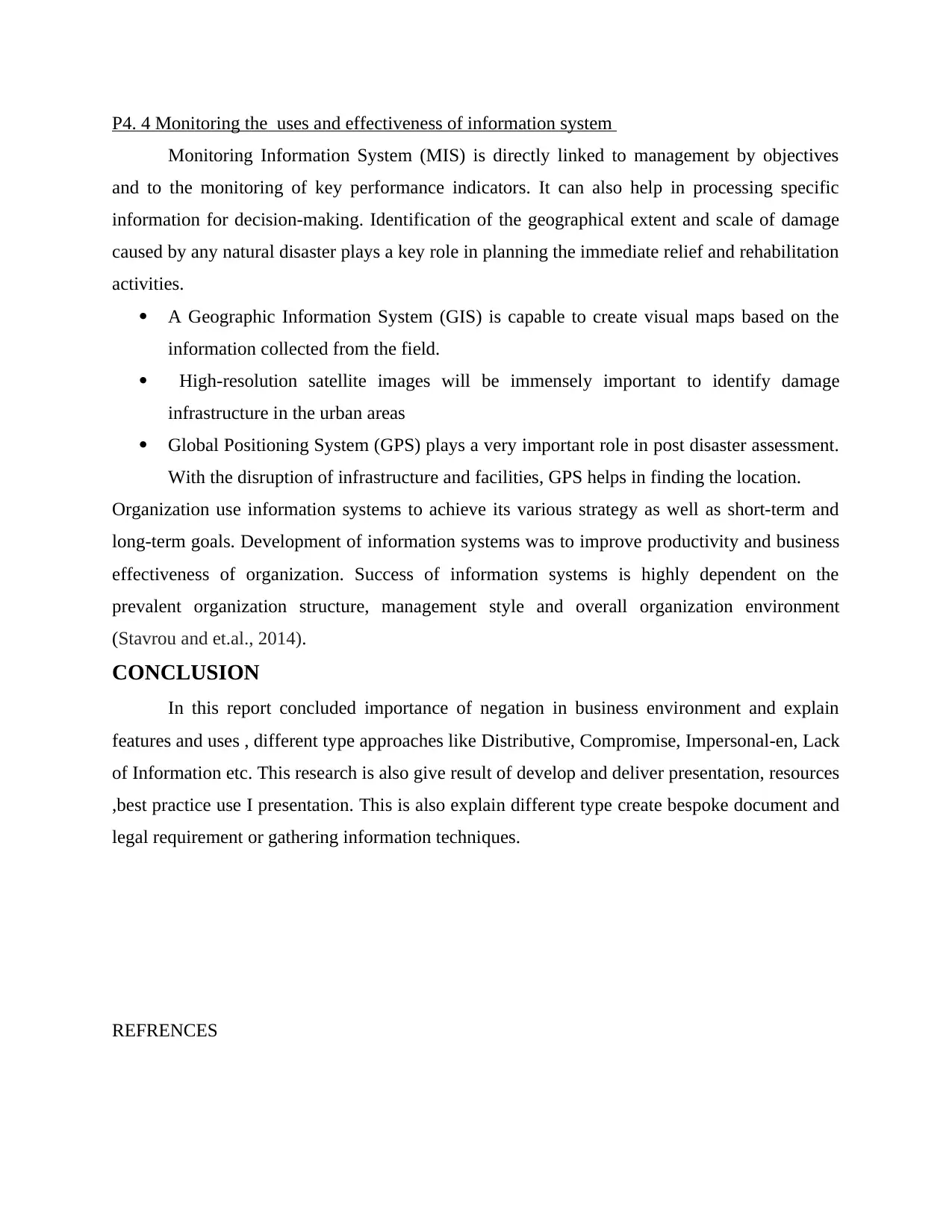
P4. 4 Monitoring the uses and effectiveness of information system
Monitoring Information System (MIS) is directly linked to management by objectives
and to the monitoring of key performance indicators. It can also help in processing specific
information for decision-making. Identification of the geographical extent and scale of damage
caused by any natural disaster plays a key role in planning the immediate relief and rehabilitation
activities.
A Geographic Information System (GIS) is capable to create visual maps based on the
information collected from the field.
High-resolution satellite images will be immensely important to identify damage
infrastructure in the urban areas
Global Positioning System (GPS) plays a very important role in post disaster assessment.
With the disruption of infrastructure and facilities, GPS helps in finding the location.
Organization use information systems to achieve its various strategy as well as short-term and
long-term goals. Development of information systems was to improve productivity and business
effectiveness of organization. Success of information systems is highly dependent on the
prevalent organization structure, management style and overall organization environment
(Stavrou and et.al., 2014).
CONCLUSION
In this report concluded importance of negation in business environment and explain
features and uses , different type approaches like Distributive, Compromise, Impersonal-en, Lack
of Information etc. This research is also give result of develop and deliver presentation, resources
,best practice use I presentation. This is also explain different type create bespoke document and
legal requirement or gathering information techniques.
REFRENCES
Monitoring Information System (MIS) is directly linked to management by objectives
and to the monitoring of key performance indicators. It can also help in processing specific
information for decision-making. Identification of the geographical extent and scale of damage
caused by any natural disaster plays a key role in planning the immediate relief and rehabilitation
activities.
A Geographic Information System (GIS) is capable to create visual maps based on the
information collected from the field.
High-resolution satellite images will be immensely important to identify damage
infrastructure in the urban areas
Global Positioning System (GPS) plays a very important role in post disaster assessment.
With the disruption of infrastructure and facilities, GPS helps in finding the location.
Organization use information systems to achieve its various strategy as well as short-term and
long-term goals. Development of information systems was to improve productivity and business
effectiveness of organization. Success of information systems is highly dependent on the
prevalent organization structure, management style and overall organization environment
(Stavrou and et.al., 2014).
CONCLUSION
In this report concluded importance of negation in business environment and explain
features and uses , different type approaches like Distributive, Compromise, Impersonal-en, Lack
of Information etc. This research is also give result of develop and deliver presentation, resources
,best practice use I presentation. This is also explain different type create bespoke document and
legal requirement or gathering information techniques.
REFRENCES
Paraphrase This Document
Need a fresh take? Get an instant paraphrase of this document with our AI Paraphraser
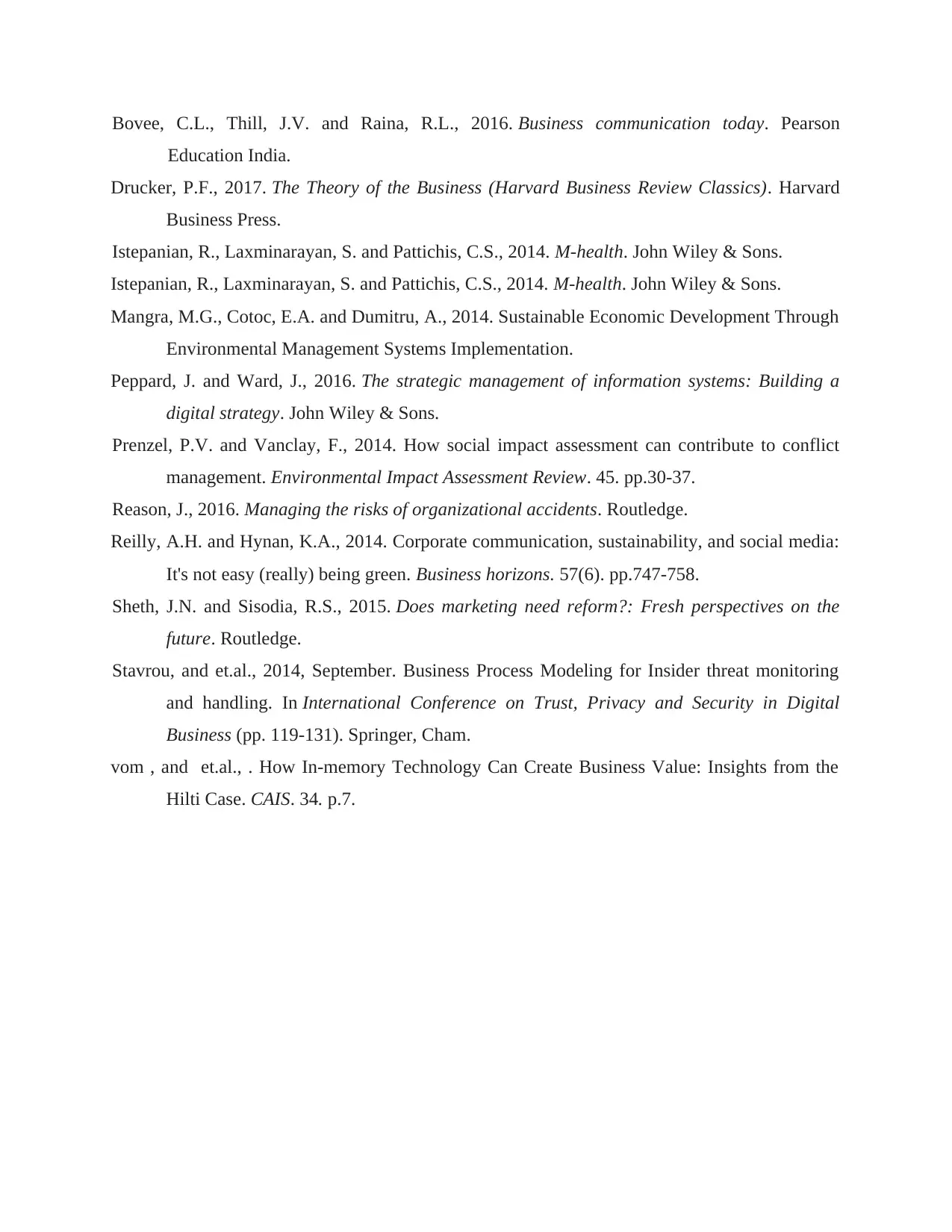
Bovee, C.L., Thill, J.V. and Raina, R.L., 2016. Business communication today. Pearson
Education India.
Drucker, P.F., 2017. The Theory of the Business (Harvard Business Review Classics). Harvard
Business Press.
Istepanian, R., Laxminarayan, S. and Pattichis, C.S., 2014. M-health. John Wiley & Sons.
Istepanian, R., Laxminarayan, S. and Pattichis, C.S., 2014. M-health. John Wiley & Sons.
Mangra, M.G., Cotoc, E.A. and Dumitru, A., 2014. Sustainable Economic Development Through
Environmental Management Systems Implementation.
Peppard, J. and Ward, J., 2016. The strategic management of information systems: Building a
digital strategy. John Wiley & Sons.
Prenzel, P.V. and Vanclay, F., 2014. How social impact assessment can contribute to conflict
management. Environmental Impact Assessment Review. 45. pp.30-37.
Reason, J., 2016. Managing the risks of organizational accidents. Routledge.
Reilly, A.H. and Hynan, K.A., 2014. Corporate communication, sustainability, and social media:
It's not easy (really) being green. Business horizons. 57(6). pp.747-758.
Sheth, J.N. and Sisodia, R.S., 2015. Does marketing need reform?: Fresh perspectives on the
future. Routledge.
Stavrou, and et.al., 2014, September. Business Process Modeling for Insider threat monitoring
and handling. In International Conference on Trust, Privacy and Security in Digital
Business (pp. 119-131). Springer, Cham.
vom , and et.al., . How In-memory Technology Can Create Business Value: Insights from the
Hilti Case. CAIS. 34. p.7.
Education India.
Drucker, P.F., 2017. The Theory of the Business (Harvard Business Review Classics). Harvard
Business Press.
Istepanian, R., Laxminarayan, S. and Pattichis, C.S., 2014. M-health. John Wiley & Sons.
Istepanian, R., Laxminarayan, S. and Pattichis, C.S., 2014. M-health. John Wiley & Sons.
Mangra, M.G., Cotoc, E.A. and Dumitru, A., 2014. Sustainable Economic Development Through
Environmental Management Systems Implementation.
Peppard, J. and Ward, J., 2016. The strategic management of information systems: Building a
digital strategy. John Wiley & Sons.
Prenzel, P.V. and Vanclay, F., 2014. How social impact assessment can contribute to conflict
management. Environmental Impact Assessment Review. 45. pp.30-37.
Reason, J., 2016. Managing the risks of organizational accidents. Routledge.
Reilly, A.H. and Hynan, K.A., 2014. Corporate communication, sustainability, and social media:
It's not easy (really) being green. Business horizons. 57(6). pp.747-758.
Sheth, J.N. and Sisodia, R.S., 2015. Does marketing need reform?: Fresh perspectives on the
future. Routledge.
Stavrou, and et.al., 2014, September. Business Process Modeling for Insider threat monitoring
and handling. In International Conference on Trust, Privacy and Security in Digital
Business (pp. 119-131). Springer, Cham.
vom , and et.al., . How In-memory Technology Can Create Business Value: Insights from the
Hilti Case. CAIS. 34. p.7.
1 out of 11
Related Documents
Your All-in-One AI-Powered Toolkit for Academic Success.
+13062052269
info@desklib.com
Available 24*7 on WhatsApp / Email
![[object Object]](/_next/static/media/star-bottom.7253800d.svg)
Unlock your academic potential
Copyright © 2020–2025 A2Z Services. All Rights Reserved. Developed and managed by ZUCOL.





